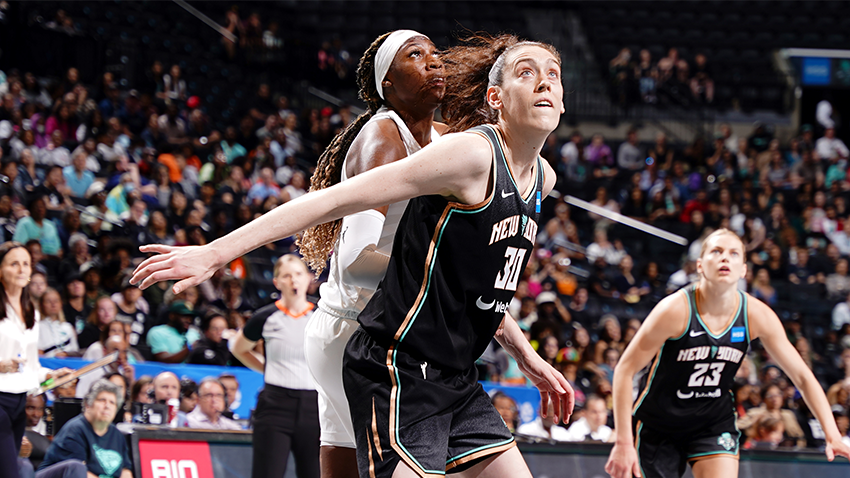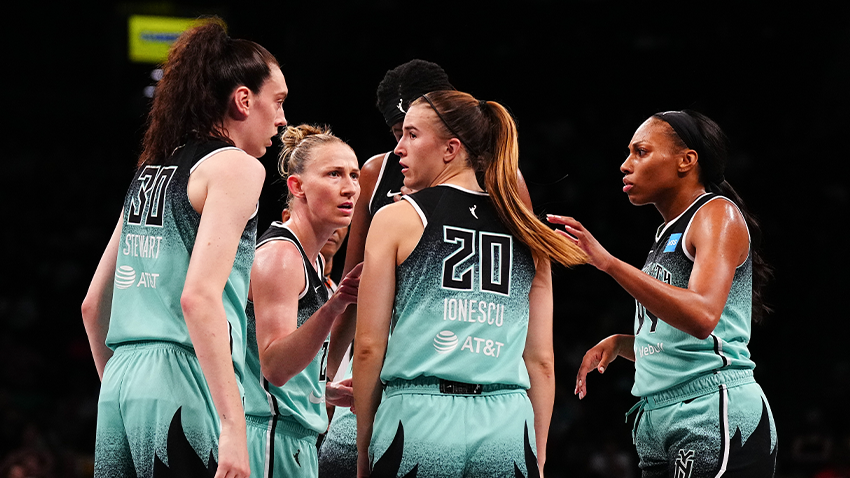ELITE is ELITE: The Clamps

In a game defined by scoring, you either get buckets or prevent them. The process is perhaps the most important thing we can dive into and discuss before exploring the defensive side of the game.
The process is also essential when watching players go to work on offense, but it’s easier to define what makes something good or great. The consistency of how someone gets to their spots with ease, the efficacy of their shot, contested or not, the way they see the court and make reads: There are many layers to parse through.
Now take those layers and add a new lens.
The variables as a player with the ball in your hands are much more controllable or at least can contemplate in that vein. Simply by not having the ball, the variables are not in your favor as a defender. It’s harder to control the game if you’re on the other end of a pick and roll.
That makes traversing the defensive side of the basketball all the more enticing. The elite defensive players in the WNBA exact their skills, knowledge, and athleticism to control the game without the ball in a way few can.
We won’t wade into every top-notch defensive player in one article (I’d need a whole book, man). Still, zooming in on a few of the best, we can take away what makes the best defensive players in basketball standout, sometimes without even being directly involved in a play.
Los Angeles Sparks guard Brittney Sykes has a case as perhaps the most athletic player in the W. While her recovery tools and lateral quickness provide her the floor to muck things up defensively, it’s Sykes’ intuitiveness as a defender that stands out for me.
She’s so active and knows the personnel on the floor incredibly well. Defensive principles are essential to consistency, but what makes basketball so great is its organics. Principles are well and good, but they shift and warp depending on who is or isn’t on the court.

Sykes sinks off the corner, and Kayla McBride lifts behind her to make herself more available as an outlet to Jessica Shepard.
Here’s the thing, though, Sykes forces this pass. By taking away Fowles, she takes away any other option, allowing her to pounce the passing lane (where her athleticism and tools come into play). Even without the ball, Sykes controls aspects of the game by playing a few steps ahead and maximizing her ability to shrink the court.
Is there a perimeter defender with a better balance of timing and aggression than Alyssa Thomas?

Thomas’ eyes are constantly scanning, and her reaction time is impeccable. The way she covers ground is mesmerizing. She reads this expertly, timing her rotation with stuttered steps at the end of her close to meet Teaira McCowan right off the catch. A step early, and that’s a defensive foul. A step late, and McCowan is on her way to an and-1.
Watch the timing on this switch.

Thomas is assigned to Natasha Howard but peels to switch onto Betnijah Laney as Howard’s screen holds up Courtney Williams. Thomas anticipates that. Considering how fast and high New York gets into the screen (3 seconds into the shot clock!!!) to target Connecticut’s weakest defender in Williams, this is such a tough action to guard.
Thomas’ ability to slide, make a play on the ball without fouling, and stay on balance is elite stuff. The preparation loading up at the nail is essential; note how quickly she’s starting to read that she’s going to slide and take Laney.
Ariel Atkins is one of the best nail defenders in basketball, leaking into the paint to draw charges or spear the ball away from ball-handlers. However, her ability to neutralize screening actions is what I most enjoy about her game.
She’s aggressive on switches, not ceding space, and always using her full length to flatten screens rather than allow them to dictate the defense.
Watch how she ICE’s this screen (angling a pick and roll on the wing to prevent middle penetration)

Atkins rams into Emma Meesseman, dictating the screen on her own terms. Rather than Meesseman directing Atkins off course, Atkins prevents a quick slip or easy ghost on the screen from popping open to the slot. If the screener is coming to drag you in the mud, why not do it back?!
She keeps her arms out, using them as a measuring stick to make Courtney Vandersloot feel her presence as she reconnects. So while Vandersloot does get the “open” shot, it’s a shot that the defense is willing to concede when put in a difficult situation. That’s good defense when you can force an empty corner pick and roll into a pull-up two.
Even if that shot fell, you tip the cap to Vandersloot and happily defend that the same next play down.
Breanna Stewart is an incredible watch defensively. Her activity is absurd. Stewart’s ability to cover ground and take away space in droves is second to none in the W. With a 7’1 wingspan, the movement skills of a guard, and sharp awareness, Stewie is a dominant defender.
The Storm play a hard hedge scheme that routinely puts two defenders on the ball when presented with a screen. The system is aggressive, playing into Stewart’s tendencies and skillset.
I mean, watch the way Stewie blows up this pick and roll and then recovers to make a play on the ball in the paint.

No player in the league averages more combined steals and blocks other than her frontcourt partner, Ezi Magbegor, and their defensive synergy pays dividends for Seattle. They trade the ability to attack on hedges or rotate low, although Magbegor has taken on much more of the role as the rotator this season.

Just Stewie is casually taking away every passing window to the left side of the court! She’s always using her length to constrict vision, constantly shifting and moving in small ways without a rhythm to throw off offensive decision-makers. She’s like a boxer throwing jabs and glancing blows from every angle possible, slipping, ducking, circling, and keeping you off balance until you make a massive mistake.

Even when Stewart cedes ground, she swallows up pick and rolls with her length. Teams routinely attempt to attack the Storm with quick slips, knowing that a hedge is likely. By waiting a half-beat here, Stewart gives Jewell Loyd the time to get back in front of Natasha Howard. Given Howard’s angling on that screen and the quickness, it makes it much harder to hedge (especially considering it’s a handoff as well).
It doesn’t matter! Stewart immediately gets her arms up, measures the distance, and blows up the play. I’d also be remiss if I didn’t put forth an appreciation of Stewart’s verticality. She’s adept at last-second adjustments to avoid fouls.

Stewart’s emblematic of playing with functional length. There are plenty of players with size and athleticism. The constant activity, exemplary footwork, and innate sense of spacing make her an exceptional defender.
Much in the same way as Stewart, Candace Parker plays in space at her size remarkably well. She’s a bit more fleet-footed than Stewart and uses her length in the same way to minimize space with activity, making her one of the better switch defenders in the W.

Chicago runs a similar scheme to Seattle but will present even more with late switches to take away middle penetration and rim attempts. Look no further than Parker’s ability to contain.
Victoria Vivians receives a hard screen from Queen Egbo, jarring Allie Quigley off-course. Parker’s footwork leading up to the screen, tip-toeing to the arc without angling her hips parallel to Egbo, allows her to veer switch (switching onto the ball-handler because the initial defender is beat, not because it’s designed for a switch to happen) crowding Vivians.
Vivians is one of the best shooters in the league: Candace’s length denies Vivians the comfortability to take a shot off the dribble after the screen. With her lateral slides and arms guiding Vivians towards the nail and away from a straight lane to the rim, she forces a difficult, well-contested shot. Awesome stuff and a consistent part of the former Defensive Player of the Year’s game.
A’ja Wilson rounds out our dive into defense with her aptitude as a rim protector. Wilson has taken a significant step forward this season as a defensive player. A large part of that is her activity as a shot-blocker, averaging the highest block rate of her career this season.
That word activity keeps popping up. Why? So much of defense is making offenses work. Even if you’re not fully shutting down an action or forcing a turnover, the consistent ability to make offenses work harder, stifling initial actions and sets, and working the clock is a huge part of being a positive defender.

Wilson plays drop often, but it’s rarely a deep drop, playing more centrefield and closer to the level of the screen. Her quick reaction time is so impressive, and she erases shots that pull-up shooters are accustomed to hitting out of ball screens.
She’s great at stopping the ball rather than swatting it. Wilson’s ability to keep the ball in play even after blocking a shot is immense for a team predicated on pace and running the break. It has been a more significant part of Las Vegas’ tremendous transition play than you’d imagine.
Wilson’s move to the five this season grabbed headlines and excitement for what that could look like (and has) offensively. But, her ability to operate as a five due to her backline communication and synchronous existence within the defense shell has given Vegas that extra pep.

Cheyenne Parker hits Wilson with a deep seal, and you credit Kelsey Plum for fighting to stay in front of Kristy Wallace. Still, these types of plays from Wilson to fight back in and muck up the paint have established her as one of the premier defensive players in basketball this season.
Defense is funny and finicky. Sometimes it’s difficult to parse why a play does or doesn’t work. Again, it’s sometimes easier to know or see what’s working offensively, as the buckets are there to back it up.
I’m still consistently learning what does or doesn’t equate to ‘good defense,’ but what always rings true is that it’s not black and white. There is a significant gray area due to the organics of basketball, but that’s a substantial reason why it’s so great. Players have tendencies, coaches have known play calls, but sometimes the ball just bounces funny. In a game full of variables, often working in favor of shot-makers and ball-handlers, the best defensive players trim the margins and dictate play.
Newly hired WNBA reporter Mark Schindler writes a column on WNBA.com throughout the season and can be reached on Twitter at @MG_Schindler. The views on this page do not necessarily reflect the views of the WNBA or its clubs.











,xPosition=.5,yPosition=.5)
,xPosition=.5,yPosition=.5)
,xPosition=.5,yPosition=.5)
,xPosition=.5,yPosition=.5)